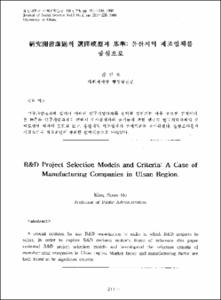영역의 계층 구조화에 의한 이동 변위 추정
- Alternative Title
- An Optical Flow Estimation Method By The Hierarchical Structuring of Image Segments
- Abstract
- 본 논문에서는 물체의 움직임이 있는 영상에 대하여, 밝기 함수의 공간 및 시간적 기울기를 토대로한 이동 변위 추정 방법에서 기존 알고리즘의 문제점을 해석하고, 이를 개선시키는 알고리즘에 대해서 논하고자 한다.
기울기를 토대로 하는 기존의 방법은 국부적인 변위를 추정하므로 전체적인 광역정보를 상실하여 오차를 발생한다. 그리고 이동 물체의 밝기 변화가 균일한 영역에서는 불완전한 조건(ill-condition)과 부적절한 배치(ill-posed)로 인한 구경(aperture) 문제로 인하여 이동 속도 추정이 어렵다. 이와 같은 문제를 해결하기 위해 운동 제한선을 이용하여 선형적으로 이동 속도를 구하고, 이를 근거로 계층구조를 구축한다. 선형적으로 구한 속도들을 4×4 윈도우로 표본화하여 확률 밀도 함수를 구하고, 확률 밀도 함수가 가장 큰 속도를 계층구조의 초기 값으로 설정하여 광역으로 전파시킨다. 계층 구조로 형성한 결과 기존의 구경(aperture) 문제를 개선시키고, 정상 상태 오차를 줄이고, 수렴 속도를 개선시켰다.
The relationship between the gradients of brightness of image is an important factor for optical flow estimation techniques. Gradient-based methods are sensitive to conditions commonly encountered in real images. highly textured surface, large constant brightness area, motion boundary and depth discontinuity can all be troublesome. These factors can be a cause of aperture problems, flow discontinuities, and so on.
In this paper, the sources of errors of local gradient-based techniques are analyzed, and an optical flow estimation algorithm using hierarchical structuring of image segments is proposed.
With the hierarchical structure the effective combination of local and global information can be achieved. The algorithm uses the image pyramids those are from the repetitive application of Gaussian filtering and decimation of the 2ⁿ: 1. For faster convergence and lower steady state errors, we used intersections of constraint lines as initial values of the first pyramid level. The experimental results on various data reveal that the proposed algorithms show faster convergence and more accurate estimation results than conventional methods.
The relationship between the gradients of brightness of image is an important factor for optical flow estimation techniques. Gradient-based methods are sensitive to conditions commonly encountered in real images. highly textured surface, large constant brightness area, motion boundary and depth discontinuity can all be troublesome. These factors can be a cause of aperture problems, flow discontinuities, and so on.
In this paper, the sources of errors of local gradient-based techniques are analyzed, and an optical flow estimation algorithm using hierarchical structuring of image segments is proposed.
With the hierarchical structure the effective combination of local and global information can be achieved. The algorithm uses the image pyramids those are from the repetitive application of Gaussian filtering and decimation of the 2ⁿ: 1. For faster convergence and lower steady state errors, we used intersections of constraint lines as initial values of the first pyramid level. The experimental results on various data reveal that the proposed algorithms show faster convergence and more accurate estimation results than conventional methods.
- Issued Date
- 1995
- Type
- Research Laboratory
- Alternative Author(s)
- Kim,Man-Woo; Choi,Won-Ho
- Publisher
- 공학연구논문집
- Language
- kor
- Rights
- 울산대학교 저작물은 저작권에 의해 보호받습니다.
- Citation Volume
- 26
- Citation Number
- 1
- Citation Start Page
- 275
- Citation End Page
- 289
- Appears in Collections:
- Research Laboratory > Engineering Research
- 파일 목록
-
-
Download
 000002024439.pdf
기타 데이터 / 704.2 kB / Adobe PDF
000002024439.pdf
기타 데이터 / 704.2 kB / Adobe PDF
-
Items in Repository are protected by copyright, with all rights reserved, unless otherwise indicated.